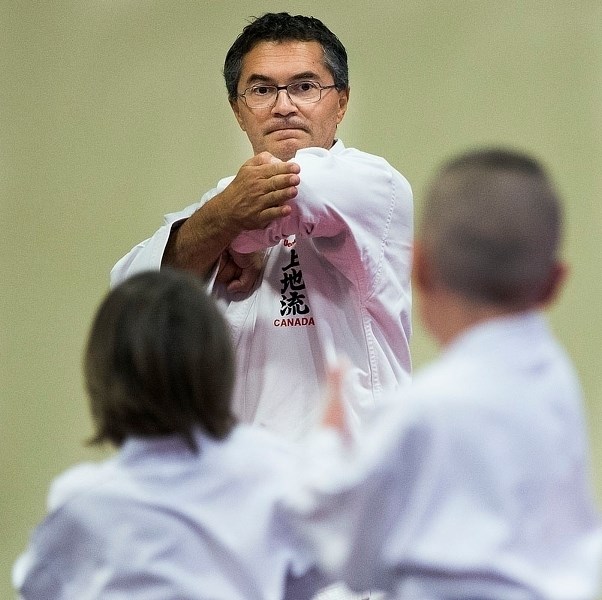A young girl, barefoot and dressed in all white, gently bows to her opponent then goes for a hard kick to send him off balance. But the boy, only nine years of age, blocks her attack, pushes her around and retaliates with a swift punch to the neck.
If this were real life, someone would be badly hurt now. But it’s not and the boy’s hand stops short before touching his opponent. She turns to face him, they bow again and start over, now with the girl blocking the attacks.
If they are lucky, they will never have to use these skills outside of the classroom, says Manuel deSa, their karate teacher, or sensei, as is the proper Japanese term.
“If you are smart, you only need to be a little bit lucky and you will never need self-defence,” he says.
The seventh-degree black belt master instructor has taught karate in St. Albert for almost two decades. His training facility, or dojo, is a large room with padded floors to soften falls, and a board on the wall where wooden signs inscribed with his students’ names hang based on their training rank, or belt colour.
The style of karate at this school is called Uechi-Ryu. It derived from a form of Chinese martial arts now taught on the island of Okinawa, Japan. There are pictures of the founder and some of his most successful students on the dojo’s walls. Two of them are deSa’s teachers, master Neil Dunnigan and grand master Kiyohide Shinjo. Shinjo learned karate from his father, who was taught by the founder himself, he says.
Another photo of an influential person in deSa’s life is framed on another wall. It’s a movie poster of Bruce Lee.
“He was one of my heroes as a kid,” he says. “Chuck Norris and Bruce Lee.”
Most people start out in karate for similar reasons, says deSa. They want to imitate the cool kicks and punches they see on TV, or learn to defend themselves. But karate is not a sport for the impatient, or fans of UFC. While some teachers may push the fighting, deSa places priority on discipline and developing mental and spiritual strength.
That being said, his classes are more relaxed than those of his Japanese teacher. There, students would never hug their sensei, play catch or joke around before class, he says. But when it comes to training, he still enforces a complicated etiquette with many ceremonial bows and other rituals to show respect towards one’s teacher and opponents. Students promise to refrain from violence, and never use their training without reason.
“If it’s about beating someone up, then this is not the school for you,” he says. “The philosophy of karate is about gaining strength and confidence so you feel better. Not so you are going around and fighting people.”
DeSa has lived by that philosophy himself. He began studying karate in his early 20s, while attending the University of Alberta. He never thought he would teach the sport one day, he says. Instead, he studied to be a lawyer and then decided to work as a child-care counsellor in Sturgeon County.
But the sport carried him through his early life and work. Friends said he became less hot-blooded and was more at ease. Knowing he was able to defend himself also helped him face young and potentially violent offenders without losing his calm. He never had to use his skills.
He sees that same change in his students today. Some of them can now stand up to their bullies at school. Others have calmed down, stopped fighting their peers and developed more confidence in life and at school.
“You are more at ease, you won’t be stressed out and worried and that gives you strength to direct your energy elsewhere,” he says.
He opened Desa School of Karate in 1996, after teaching a few classes in Sturgeon County at night. When more people wanted to join, he decided to change professions for good. He still counsels youth, though, now talking to students in his office after class.
“There is the odd evening in here where I do more counselling than teaching,” he laughs. “But it’s part of the same thing. We are a karate family. We help each other out.”
There are about 130 students at his school, many of them young children and youth. Training costs more than $100 per month, which is not cheap, admits deSa, but he promises quality training in return. Most students train once or twice a week, with the majority of classes offered at night.
DeSa also practices twice a week and meets his instructor in Japan at least once a year, to learn new skills or perfect old ones. In any martial arts education, the teacher is crucial, he says. You can love the sport but if you get the wrong coach, you don’t enjoy it, he says.
“My trips abroad are very important. For my spirit, for my mind, to come back refreshed,” he says. “If I didn’t do that the students would start getting tired. And you get bitter.”
That being said, not every student lasts through the first year of training. DeSa may joke with them but also pushes them hard during training. Every few months, they undergo tests that can promote them up the ranks. The white belt is at the lowest level, the black belt is at the highest, with several colours in between.
DeSa says some people come with a natural talent but quickly lose interest. Others must practice a lot, and surprise you one day. But he is proudest when parents tell him how their child succeeds outside of class because of karate.
“That’s when I feel just honoured,” he says.




